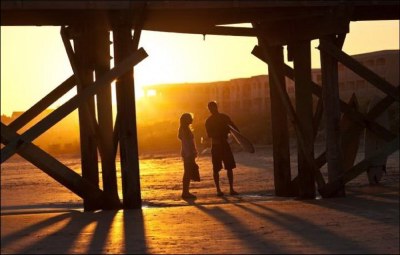channing tatum - dear john production notes
|
The Vow 2012
21 Jump Street 2012
Haywire 2012
The Son of No One 2011
Dear John 2010
Fighting 2009
Stop-Loss 2008
Step Up 2006
She's the Man 2006
|
 Dear John was shot almost entirely within and around the beautiful and historic city of Charleston, South Carolina. The varied architecture and rich landscape provided settings for Savannah's beach house (Sullivan's Island), the pier where the lovers meet (Isle of Palms) and the beach where they argue (Folly Beach). The actual Bowens Wharf Restaurant, the site of their first date, and Mr. Tyree's house, where John grew up, are on James Island. Savannah writes and receives John's letters at the historic Randolph Hall at the College of Charleston (where scenes from The Notebook, Cold Mountain, and The Patriot were also filmed), and her parents' home and horse farm is the Cassina Point Plantation in Edisto.
“When we were looking for Savannah's parents' house,” says Bowen, “we wanted a place that gave the audience a sense of family history - not necessarily their wealth, but the fact they'd been on this place for generations. It was hard to find one that wasn't grand and didn't take your breath away, but we found a place that doesn't feel ostentatious…and still takes your breath away.”
According to Tecla Earnshaw (Cassina Point's current owner), the house was built in 1847 by Carolina Lafayette Seabrook (of an old Edisto family) and her husband James Hopkinson of Philadelphia (grandson of Francis Hopkinson, a signatory of the Declaration of Independence for the state of NJ and the reputed designer of the Betsy Ross flag). In its heyday the plantation raised the wildly popular sea-island cotton shipped to Europe. The family lived in the house until 1861 when Port Royal fell to the Federal Navy and Confederate General Robert E. Lee ordered area families to evacuate. Union troops occupied the island, leaving graffiti in the house's basement.
After the Civil War, the family regained possession of the house and, although it now lived a much-lowered economic status, kept it from deterioration. Electricity was installed in 1951. It remained in the family until 1987; its current owners, Tecla and Bill Earnshaw, who operated the house as a bed-and-breakfast for nine years, are only the third owners. They continue to restore the house.
“I love South Carolina,” says Channing Tatum. “I'm from the South, so I have an addiction with it. The food, the people, the lifestyle. It's just so charming. And the Southern fried chicken. The seafood. Barbeque. Jim and Nick's cheese muffins - they're amazing.”
Amanda Seyfried loved South Carolina as well. “The South is a whole different thing altogether,” she says. “It's got something - an energy. It's romantic. It's just so beautiful. It brings something to a film you can't get anywhere else in the world.”
The Charleston area provided logical locations for the scenes set in South Carolina, but a portion of Dear John takes place in foreign countries where soldier John serves. “We had to create not only Charleston locations, but Germany, Afghanistan, Africa, the Congo and Eastern Europe - all in Charleston,” says production designer Kara Lindstrom. “The biggest challenge was time and money. The eastern European café is an abandoned elementary school in downtown Charleston. The bombed-out Afghan village [where John is wounded] was shot at a partially demolished cement factory that looked like a bomb had actually hit it in Harleyville, SC, about an hour north of Charleston. We had two different African locations: a military installation on the Congo coast, which was built at Fort Moultrie, an historic site that played roles in the Revolutionary and Civil Wars (including the shelling of Fort Sumter), and a village complete with indigenous animals that was built along a piece of grassland at the cement factory up above the quarry.”
“You have to be very creative to create locations from around the world in a localized area,” says Bowen. “It took an incredibly talented production design team to be make audiences believe that they're looking at Africa and not a fort just outside of Charleston.”
Director of photography Terry Stacey was inspired by the locations. “When I first read the script,” Stacey says, “it felt like an old-fashioned classic like A Farewell To Arms, and that widescreen was the way to give the film an epic quality and capture the richness of the many different locations. We wanted to create the world of Charleston as a very lush landscape, using a lot of big moving crane and stationary shots that contrast with the more raggedy, handheld and harsher war scenes."
|